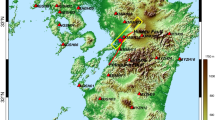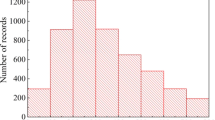Abstract
An effective approach to simulate the multi-support earthquake underground motions is proposed in this paper and the key factor for this approach (i.e. underground cross-correlation function) is presented in advance and elaborated. Previous studies are mainly focused on the multi-support ground motions due to the absence of the necessary conditions to simulate underground motions, i.e., underground power spectral density (PSD), underground response spectrum and, especially, underground cross-correlation function. In this paper, the underground PSD and response spectrum are firstly derived and the cross-correlation function between the underground motions at positions with different horizontal and vertical coordinates is further deduced. The physical meanings of the parameters in this approach are explicitly clarified. Moreover, a program for generating the multi-support earthquake underground motions is developed and the reliability of the generated underground motions is verified. Finally, a two-span bridge is taken as an example to investigate structural responses under multi-support earthquake underground excitations. Numerical results show that the dynamic responses under multi-support earthquake underground motions are significantly different from those under multi-support earthquake ground motions. Results indicate that the simulation of multi-support earthquake underground motions is significant for both study and engineering application.

























Similar content being viewed by others
References
Abrahamson NA, Schneider JF, Stepp JC (1991) Empirical spatial coherency functions for application to soil-structure interaction analyses. Earthq Spectra 7(1):1–27
Alexander NA (2008) Multi-support excitation of single span bridges, using real seismic ground motion recorded at the SMART-1 array. Comput Struct 86(1–2):88–103
Atkinson KE (1978) An introduction to numerical analysis. Wiley, New York
Berrah M, Kausel E (1992) Response spectrum analysis of structures subjected to spatially varying motion. Earthq Eng Struct Dyn 21(6):461–470
Bi K, Hao H (2011) Influence of irregular topography and random soil properties on coherency loss of spatial seismic ground motions. Earthq Eng Struct Dyn 40(9):1045–1061
Bi K, Hao H (2012) Modelling and simulation of spatially varying earthquake ground motions at sites with varying conditions. Probab Eng Mech 29:92–104
Chopra AK (2001) Dynamics of structures: theory and applications to earthquake engineering, 2nd edn. Prentice Hall, Englewood Cliffs
Clough RW, Penzien J (1993) Dynamics of structures, 2nd edn. McGraw-Hill Inc, New York
Der Kiureghian A (1996) A coherency model for spatially varying ground motions. Earthq Eng Struct Dyn 25(1):99–111
Guo W, Yu ZW, Liu GH, Guo Z (2013) Possible existing seismic analysis errors of long span structures and bridges while utilizing multi-point earthquake calculation models. Bull Earthq Eng 11(5):1683–1710
Hao H (1989) Effects of spatial variation of ground motion on large multiply-supported structures. In: EERC Rep No 89-06, Earthquake Engineering Research Center, University of California, Berkeley
Hao H, Oliveira CS, Penzien J (1989) Multiple-station ground motion processing and simulation based on smart-1 array data. Nucl Eng Des 111(3):293–310
Kiureghian AD, Neummhofer A (1992) Response spectrum method for multi-support seismic excitations. Earthq Eng Struct Dyn 21(8):713–740
Konakli K, Der Kiureghian A (2012) Simulation of spatially varying ground motions including incoherence, wave-passage and differential site-response effects. Earthq Eng Struct Dyn 41(3):495–513
Liu GH, Li HN, Tian L (2009) Response analysis of JIUJIANG Yangtze River highway bridge under spatially variable earthquake ground motions. J Vib Shock 28(9):204–209 (in Chinese)
Liu GH, Lu XZ, Guo W (2012) Multi-point seismic motions based on focal mechanism and considering local site multi-layer soil effect: theory and program implementation. Chin J Comput Mech 29(4):582–588 (in Chinese)
Lou L, Zerva A (2005) Effects of spatially variable ground motions on the seismic response of a skewed, multi-span, RC highway bridge. Soil Dyn Earthq Eng 25(7):729–740
Maharaj KK (1978) Stochastic characterization of earthquakes through their response spectrum. Earthq Eng Struct Dyn 6(5):497–509
MOHURD (2011) Code for seismic design of urban bridge (CJJ 166-2011). Ministry of Housing and Urban-Rural Development of the People’s Republic of China, Beijing (in Chinese)
Schnabel PB, Lysmer J, Seed HB (1972) SHAKE: a computer program for earthquake response analysis of horizontally layered sites. Report No. UCB/EERC-72/12, University of California, Berkeley
Sextos AG, Kyriazis DP, Andreas JK (2003) Inelastic dynamic analysis of RC bridges accounting for spatial variability of ground motion, site effects and soil–structure interaction phenomena. Part 1: methodology and analytical tools. Earthq Eng Struct Dyn 32(4):607–627
SHAKE2000 Consulting Group (2000) SHAKE2000 User’s manual, Berkeley
Shrestha B, Hao H, Bi K (2014) Effectiveness of using rubber bumper and restrainer on mitigating pounding and unseating damage of bridge structures subjected to spatially varying ground motions. Eng Struct 79:195–210
Soize C (2006) Non-Gaussian positive-definite matrix-valued random fields for elliptic stochastic partial differential operators. Comput Method Appl M 195(1):26–64
Su L, Shi JT (2013) Displacement-based earthquake loss assessment methodology for RC frames infilled with masonry panels. Eng Struct 48:430–441
Su L, Dong SL, Kato S (2006) A new average response spectrum method for linear response analysis of structures to spatial earthquake ground motions. Eng Struct 28(13):1835–1842
Ta Q-A, Clouteau D, Cottereau R (2010) Modeling of random anisotropic elastic media and impact on wave propagation. Eur J Comput Mech 19(1–3):241–253
Tian L, Li HN (2012) Seismic response of power transmission tower-line system under multi-component multi-support excitations. J Earthq Tsunami 6(4):1250025
Tian YJ, Yang QS (2009) On time-step in structural seismic response analysis under ground displacement/acceleration. Earthq Eng Eng Vib 8(3):341–347
Tian L, Ma RS, Li HN, Zhang P (2014) Seismic response of straight line type and broken line type transmission lines subjected to non-uniform seismic excitations. Adv Steel Constr 10(1):85–98
Xu ZD (2010) Review for dynamic researches in civil engineering in recent years. Sci China Technol Sci 53(5):1450–1452
Ye JH, Zhang ZQ, Chu Y (2011) Strength behavior and collapse of spatial-reticulated structures under multi-support excitation. Sci China Ser E 54(6):1624–1638
Yu RF, Zhou XY (2008) Response spectrum method analysis for non-classically damped linear system with multiple-support excitations. Bull Earthq Eng 6(2):261–284
Zentner I, Poirion F (2012) Enrichment of seismic ground motion databases using Karhunen–Loève expansion. Earthq Eng Struct Dyn 41(14):1945–1957
Zerva A (1990) Response of multi-span beams to spatially incoherent seismic ground motions. Earthq Eng Struct Dyn 19(6):819–832
Zerva A (2002) Spatial variation of seismic ground motions: an overview. Appl Mech Rev 55(3):271–297
Zerva A (2009) Spatial variation of seismic ground motions: modeling and engineering applications (Advances in engineering series). CRC Press, Boca Raton
Zhang N, Xia H, Roeck GD (2010) Dynamic analysis of a train-bridge system under multi-support seismic excitations. J Mech Sci Technol 24(11):2181–2188
Acknowledgements
This work was supported by the National Natural Science Foundation of China (Grant Nos. 51408409 and 51579173) and the Tianjin Research Program of Application Foundation and Advanced Technology (Grant No. 15JCQNJC07400).
Author information
Authors and Affiliations
Corresponding authors
Rights and permissions
About this article
Cite this article
Liu, G., Lian, J., Liang, C. et al. An effective approach for simulating multi-support earthquake underground motions. Bull Earthquake Eng 15, 4635–4659 (2017). https://doi.org/10.1007/s10518-017-0153-3
Received:
Accepted:
Published:
Issue Date:
DOI: https://doi.org/10.1007/s10518-017-0153-3




